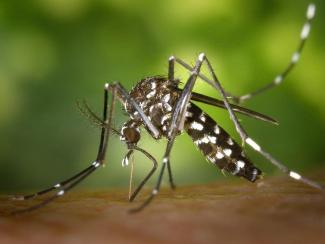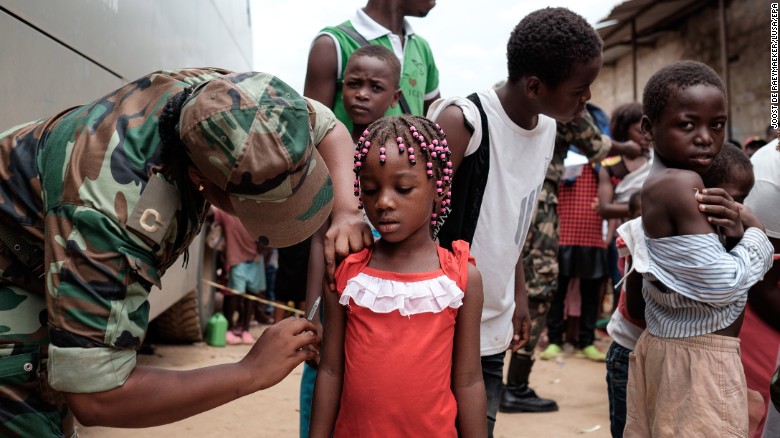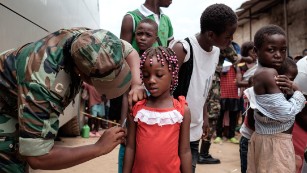
Joost De Raeymaeker/EPA
Locals wait in line for vaccinations in the Angolan capital Luanda after an outbreak of yellow fever.
As the
largest outbreak of yellow fever in almost 30 years continues to spread in Angola, scientists are warning that the world is ill-prepared for what would be a public-health calamity: the re-emergence of urban epidemics of the deadly infection, which could overwhelm vaccine stockpiles.
Yellow fever virus caused devastating outbreaks in cities in the past, but by the 1970s its mosquito carrier in urban areas —
Aedes aegypti — had been wiped from large swathes of the globe; vaccination programmes also helped to confine the virus to the jungle. But now, as a result of the scaling-back of control efforts,
Aedes mosquitoes have re-emerged in
densely populated tropical and subtropical cities where many people are unvaccinated — and the Angolan situation has renewed fears that the virus might be poised to break out from the jungle.
Worst of all would be if yellow fever gains a foothold in Asia — where, mysteriously, it has never become established despite apparently ideal ecological conditions. “We don’t know if this will happen, but if it does it would be a public-health disaster,” says Duane Gubler, a researcher in mosquito-borne diseases at Duke-NUS Medical School in Singapore.
Yellow fever, which is endemic in parts of South America and Africa, causes at least 60,000 deaths each year. Many people who become infected recover quickly (there are 84,000–170,000 annual infections, more than 90% of them in Africa), but some develop jaundice, bleed from their orifices and sustain fatal organ damage.
A 2006 initiative led by the World Health Organization (WHO) upped mass vaccinations and introduced routine immunization of children in many high-risk countries in Africa, but vaccination rates remain too low. The Angolan outbreak points to the continued risk posed by yellow fever: it began last December in the capital Luanda and has since spread to 6 of the country’s 18 provinces. Officially, some 490 people have been infected and 198 have died, although the true figures are probably much higher.
The immediate concern is that the virus might spread to larger African urban centres, as happened in the biggest previous outbreak, which began in 1986 in Nigeria and ultimately infected 116,000 people and killed 24,000 (see ‘
Where might yellow fever go next?’).

Sources: M. U. G. Kraemer et al. eLife 4, e08347; 2015 (Mosquito distribution); www.cdc.gov/yellowfever/maps (transmission risk areas)
Africa’s urban populations are now much larger than they were in the 1980s, notes Thomas Monath, a yellow fever and vaccine specialist who is chief scientific officer of NewLink Genetics in Ames, Iowa. People who contracted the infection in Angola have already carried it to Kenya, Mauritania and the Democratic Republic of the Congo, although this hasn’t yet sparked new outbreaks.
From jungle to city
As long as the virus is confined mainly to small outbreaks in Africa, the world’s vaccine production — just over 40 million doses annually — should be sufficient to replenish emergency stockpiles and contain outbreaks, says William Perea, who coordinates the WHO’s Control of Epidemic Diseases Unit in Geneva, Switzerland.
But the fear is that yellow fever could follow the same path as other less-severe mosquito-borne diseases, such as
dengue,
chikungunya and
Zika, which have already seen major urban epidemics tied to the resurgence of
Aedes mosquitoes.
Scientists are struggling to assess that risk, in part because there is little research on the virus. In South America, for instance, despite endemic jungle yellow fever and A. aegypti-infested cities, urban outbreaks are almost unheard of. This may be because populations of monkeys and jungle mosquitoes (the reservoirs for the virus) are smaller than in Africa, and because of relatively high vaccination rates among people living in or near the jungle.
Yellow fever also seems to spread less easily by Aedes mosquitoes than do other viruses such as dengue, says Pedro Fernando da Costa Vasconcelos, an infectious-disease researcher who is director of the Evandro Chagas Institute in Ananindeua, Brazil.
Nevertheless, the WHO estimates that South America is now “
at greater risk of urban epidemics than at any time in the past 50 years”. Vaccination is officially recommended only in areas where the virus is endemic, because the vaccine can have serious — sometimes fatal — side effects in around 1 in 100,000 people. This means that few people are vaccinated on the densely populated eastern seaboard of Brazil, for example, because the region is the only part of the country where the virus is not endemic.
In Asia, the absence of yellow fever is an enigma: the continent has the monkeys, mosquitoes and climate in its warm regions that seem ideal conditions for the virus to thrive. Furthermore, infected travellers from elsewhere have introduced the virus to the region many times, and Asian populations don’t have any specific resistance to yellow fever.
One hypothesis, says Gubler, is that strains of dengue and other related flaviviruses have for centuries been so prevalent that they offer cross-protection against yellow fever — and so viral loads are reduced to levels below those required to sustain mosquito-borne cycles of disease. But with the recent unbridled growth of large cities and mosquito-infested slums, Asia’s past freedom from yellow fever may be no guide to its future, Gubler cautions.
The Angolan outbreak has also heightened concerns because hundreds of thousands of people from China and other Asian countries now work in Angola and in other at-risk parts of Africa, and many are unvaccinated, says Monath. Several unvaccinated individuals have fallen ill with yellow fever after returning from Angola to southern China.
Vaccine stocks
Many specialists want authorities to increase international vaccine stockpiles and to accelerate vaccination campaigns in endemic areas. But that would require boosting funding commitments to guarantee a market for manufacturers of the vaccine, Pereas says. Currently, there are only four suppliers worldwide, and supply is falling short of demand. (In a crisis, the WHO could dilute vaccines tenfold to boost its stocks without negating the vaccines’ effectiveness. But the process would require a specific kind of single-use, small-volume syringe, which is not commercially available, Pereas adds.)
Gubler argues that vaccination should be considered in A. aegypti-infested cities close to endemic regions in Africa and South America. In Asia, the risk is too uncertain to recommend vaccination now, he says, but health-care workers there need to be trained to identify cases so that any outbreaks can be nipped in the bud. Renewed efforts to curb A. aegypti mosquitoes globally are also essential, he adds.
For now, the area of most immediate concern is Africa — where some countries, such as Nigeria, have less than 50% yellow fever vaccination coverage. The availability of vaccines has led to ill-founded complacency about the threat posed by yellow fever, warns Perea. “It’s a neglected and forgotten disease.”


/cdn0.vox-cdn.com/uploads/chorus_asset/file/6342739/GettyImages-151052126.0.jpg)
/cdn0.vox-cdn.com/uploads/chorus_asset/file/6342545/Screen%20Shot%202016-04-15%20at%2011.11.28%20AM.png)
/cdn0.vox-cdn.com/uploads/chorus_asset/file/5936919/a_aegypti_0.0.png)



